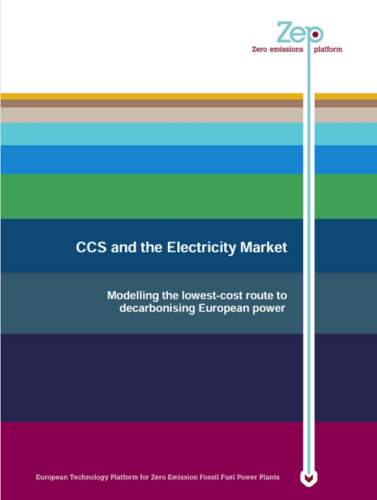CCS and the Electricity Market: Modelling the lowest-cost route to decarbonising European power
About the report
To identify how low-carbon technologies can reduce European power emissions most cost-effectively in the horizon to 2050, the Zero Emissions Platform (ZEP) has developed a model based on an existing model from the Norwegian University of Science and Technology (NTNU) and linked it to the Global Change Assessment Model (GCAM).
ZEP’s model is designed to select the lowest-cost investments to meet expected electricity demand, while replacing plants that exceed a defined lifetime, country by country. It is unique in that it not only takes into account optimised operating costs hour-by-hour, but also has a dispatch model for renewable power based on capacity factors and historic weather data.
Executive summary
ZEP’s model shows the lowest-cost route to decarbonising European power
To identify how low-carbon technologies can reduce European power emissions most cost-effectively in the horizon to 2050, the Zero Emissions Platform (ZEP) has developed a model based on an existing model from the Norwegian University of Science and Technology (NTNU) and linked it to the Global Change Assessment Model (GCAM).
ZEP’s model is designed to select the lowest-cost investments to meet expected electricity demand, while
replacing plants that exceed a defined lifetime, country by country. It is unique in that it not only takes into account optimised operating costs hour-by-hour, but also has a dispatch model for renewable power based on capacity factors and historic weather data.
Baseline modelling highlights the critical role of CCS as early as 2030
Cases studied in the baseline modelling show that the wide and progressive use of lignite, coal, gas, and biomass with CO2 Capture and Storage (CCS) between 2030 and 2050, combined with a large expansion in hydro, wind, and solar, is the lowest-cost route to achieving an 80% absolute reduction in emissions from power. This is documented in ZEP’s report, “CO2 Capture and Storage (CCS) – Recommendations for
transitional measures to drive deployment in Europe”, published in November 2013
CCS is needed to meet electricity demand and climate targets – cost-effectively
Having such a powerful model available, ZEP decided to undertake further modelling in response to
questions from the European Commission and other stakeholders:
- If CCS is excluded altogether, what is the impact on costs and emission reductions?
If CCS is not available to the model and limits on onshore wind and solar photovoltaics (PV) from the original modelling are maintained, electricity demand is not met after 2045 because the model’s 80% emission reduction target cannot be achieved without CCS. Blackouts are a possible consequence. - What if the cost of solar in 2050 is also much lower than originally estimated?
If the cost of solar is drastically reduced from 1,000 to 200 €(2010)/kW installed in 2050 – requiring a
major technology breakthrough compared to today – demand is still not met after 2045, and the cost to Europe is 20-50% higher than with CCS. - What if the limits on solar and wind are also relaxed?
To see if the above results were robust, limits on the amount of onshore wind and PV were also relaxed – including cases with no limits whatsoever. The latter results in 600 GW of PV and 1,000 GW of wind in 2050 with the original PV cost; up to 1,500 GW of PV and 640 GW of wind with the low PV cost. This represents up to 200,000 5 MW-class wind turbines and up to 10,000 km2 of Europe’s surface covered with PV. Even if this were practically possible, the cost is 35-45% higher than equivalent cases with CCS. - What is the impact of electricity storage on costs?
If the model is allowed to select electricity storage to help integrate the renewables, this only has a
limited effect (from 2040 onwards) and plays a small role in reducing costs.
Without CCS, the cost of decarbonising European power is 20-50% higher by 2050
Even when the limits on PV and wind are relaxed and the cost of PV is significantly reduced, CCS still plays
a critical role in the generation mix, reducing the cumulative cost of European power by 20-50% by 2050.
This represents some €2-4 trillion – a substantial amount compared to, for example, the ~€150 billion
annual electricity expenses incurred by European industry.
